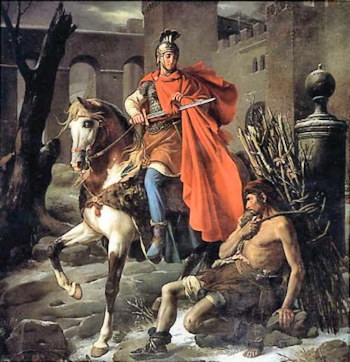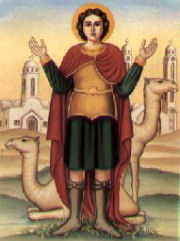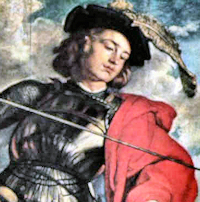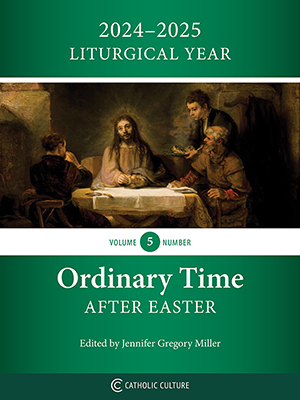Ordinary Time: November 11th
Memorial of St. Martin of Tours, Bishop; Veterans Day (USA)
Other Commemorations: St. Mennas of Egypt, Martyr (RM) ; Other Titles: Martinstag, Martini; Martinmas
» Enjoy our Liturgical Seasons series of e-books!
Today the Church celebrates the Memorial of St. Martin of Tours, bishop (ca. 316-398). St. Martin is the first bishop and confessor honored by the Church in the West. He was a principal apostle of Gaul, where his feast was celebrated as a holyday of obligation with an octave and popular celebrations.
It is also Veterans Day in the USA (formerly Armistice Day). This coincides with Remembrance Day or Armistice Day celebrated in other countries. Veterans Day is set aside for honoring military veterans of the United States Armed Forces.
The Roman Martyrology also commemorates St. Mennas of Egypt(d. 300), an Egyptian soldier and martyr, put to death during Diocletian's reign.
Veterans Day (USA), Remembrance Day (Canada)
On the eleventh hour of the eleventh day in the eleventh month of the year 1918, an armistice was signed, ending the "war to end all wars." November 11 was set aside as Armistice Day in the United States to remember the sacrifices that men and women made during the war in order to ensure a lasting peace. In 1938 Congress voted Armistice Day as a legal holiday, but World War II began the following year. Armistice Day was still observed after the end of the Second World War. In 1953 townspeople in Emporia, Kansas called the holiday Veterans Day in gratitude to the veterans in their town. Soon after, Congress passed a bill renaming the national holiday to Veterans Day. Today, we remember those who have served for our country in the armed forces in our prayers. For more information, read about Veterans Day.
Prayers for those in service and for their families may be found here.
St. Martin of Tours
 St. Martin was born (c. 316) at Sabaria, a town in Pannonia near the famous Benedictine monastery dedicated to his name. Against the wishes of his parents he associated with Christians and became a catechumen at the age of ten. At fifteen he entered the army and served under the Emperors Constantius and Julian. While in the service he met a poor, naked beggar at the gates of Amiens who asked alms in Christ's Name. Martin had nothing with him except his weapons and soldier's mantle; but he took his sword, cut the latter in two, and gave half to the poor man. During the following night Christ appeared to him clothed with half a mantle and said, "Martin, the catechumen, has clothed Me with this mantle!"
St. Martin was born (c. 316) at Sabaria, a town in Pannonia near the famous Benedictine monastery dedicated to his name. Against the wishes of his parents he associated with Christians and became a catechumen at the age of ten. At fifteen he entered the army and served under the Emperors Constantius and Julian. While in the service he met a poor, naked beggar at the gates of Amiens who asked alms in Christ's Name. Martin had nothing with him except his weapons and soldier's mantle; but he took his sword, cut the latter in two, and gave half to the poor man. During the following night Christ appeared to him clothed with half a mantle and said, "Martin, the catechumen, has clothed Me with this mantle!"
Martin was eighteen years old when he received the sacrament of holy baptism. At the pleading of his superior officer, he remained two years longer in the army. Then, upon requesting dismissal, Julian accused him of cowardice. "With the sign of the Cross," Martin answered, "I shall more certainly break through the ranks of the enemy than if armed with shield and sword." When released he sought out St. Hilary, bishop of Poitiers, and was ordained. Later he was made bishop of Tours. Close to the city he built a monastery (Marmoutier), where with eighty monks he led a most holy life. On one of his numerous visits to the imperial court at Trier, a certain man besought him to help his daughter, "I firmly believe in the Lord that my daughter will be healed through your prayer." Martin healed the girl with consecrated oil. Tetradius, who witnessed this extraordinary manifestation of divine power, asked for baptism.
Martin also possessed the gift of discerning spirits. Once the devil appeared to him radiant and clothed in royal apparel, and spoke as if he were Christ. Martin, recognizing the deceit, replied, "The Lord Jesus Christ never prophesied that He would come in purple robes and royal crown." The apparition immediately vanished. Three dead persons he raised to life. While celebrating holy Mass a luminous sphere appeared over his head. He was far advanced in age when he fell into a grievous fever during a visitation at Candes, an outlying parish of his diocese. Unceasingly he begged God to release him from this mortal prison. His disciples, however, implored him with tears, "Father, why are you leaving us? To whom will you entrust the care of your disconsolate children?" Deeply moved, Martin turned to God: "Lord, if I am still necessary for Your people, I will not refuse the labor. Your will be done!"
When the bystanders saw that despite his great fever he remained lying on his back, they besought him to change position to alleviate somewhat the pain. But Martin answered, "Brothers, rather let me look toward heaven than to earth so that my soul in its journey home may take a direct flight to the Lord." Shortly before death he saw the evil spirit. "What do you want, horrible beast? You will find nothing in me that's yours!" With those words the aged saint breathed forth his soul on November 11, 397, at the age of eighty-one.
—Excerpted from The Church's Year of Grace, Pius Parsch
St. Martin's feast, also known as "Martinmas" in Europe arrives in autumn, the beginning of the wine harvest. This was also the time of slaughter of the stock for winter meat. His images are usually depicted with a goose, symbolizing that Martinmas was the last festive meal before Advent, because in France in the Middle Ages, the strict 40 day Advent fast (called Quadragesima Sancti Martini or Forty Days' Fast of Saint Martin's) began the next day. So in past centuries November 11 was celebrated as a thanksgiving day. Thus it was the custom to have "St. Martin's Goose" and taste the new wine ("Saint Martin's Wine") on his feast day. A quick spell of warm weather around his feast day (usually termed "Indian Summer" in the US) is known as "St. Martin's Little Summer" in Europe.
Patronage: Against impoverishment; against poverty; alcoholism; beggars; Burgenland; cavalry; equestrians; France; geese; horse men; horses; hotel-keepers; innkeepers; Mainz, Germany; quartermasters; reformed alcoholics; riders; soldiers; tailors; vintners; wine growers; wine makers. See CatholicSaints.info for a whole long list of patronage.
Symbols and Representation: Horse; sword and coat cut in halves; goose; scourge; hare; broken images; chair in flames; demon at his feet; globe of fire;
Often Portrayed As: Man on horseback sharing his cloak with beggar; man cutting cloak in half
Highlights and Things to Do:
- Pray the Iste Confessor in honor of St. Martin.
- Cook a special dinner of roast goose or duck in honor of St. Martin. Bake some horseshoe cookies. See the extensive list of recipes in the right blue sidebar, and also visit Catholic Cuisine for other recipe inspiration.
- In Europe this day is traditionally known as Martinmas. Many foods and traditions are connected with this day. See also the archive of Women for Faith and Family for more Catholic traditions.
- St. Martin is patron saint of wine growers, wine makers and vintners. In France, the tasting of the new wine is done today. Have a Martinmas gathering, serving this year's Beaujolais noveau wine from France.
- Read Painting Angels, Saints and Their Symbols for a discussion about St. Martin's symbols in art.
- Learn more about St. Martin:
- St. Martin's relics rested in the original Basilica of Tours, a scene of pilgrimages and miracles, until 1562 when the catheral and relics were destroyed by militant Protestants. Some small fragments of his relics in his tomb were found during construction excavation in 1860. These remaining relics of St. Martin are in the newer Basilique Saint Martin (Basilica of St Martin) in Tours, France. This church was built between 1886 and 1924 by French architect Victor Laloux to replace the medieval church that was destroyed in the French Revolution.
- See the Life of St Martin as depicted in the stained glass of Chartres Cathedral (c.1220).
- The children will enjoy this dessert St. Martin's Horseshoes and you can learn more about customs for this feast.
- See Christian Iconography for images of St. Martin of Tours.
- Read about the Real St. Martin of Tours by Jennifer Gregory Miller.
St. Mennas
 St. Mennas, according to legend a Christian soldier from Egypt, left the Roman army during the persecution of Diocletian and Maximian to go into the desert and do penance. On the Emperor's birthday, which the people celebrated with outdoor spectacles, he entered the theatre at Cotyaeum and openly mocked belief in pagan gods. He was seized and cruelly scourged by Pyrrhus, the official in charge. Tied to the rack, his whole body was burned with torches, brushed with thorns, torn with leaden whips. He was finally beheaded and his body thrown into the fire. Christians took what remained and gave it honorable burial. His grave, close to Alexandria, became such a famous place of pilgrimage that, as at Lourdes today, a whole town arose to accommodate the pilgrims. Many small phials or eulogia have been found there which show St. Mennas between two kneeling camels.
St. Mennas, according to legend a Christian soldier from Egypt, left the Roman army during the persecution of Diocletian and Maximian to go into the desert and do penance. On the Emperor's birthday, which the people celebrated with outdoor spectacles, he entered the theatre at Cotyaeum and openly mocked belief in pagan gods. He was seized and cruelly scourged by Pyrrhus, the official in charge. Tied to the rack, his whole body was burned with torches, brushed with thorns, torn with leaden whips. He was finally beheaded and his body thrown into the fire. Christians took what remained and gave it honorable burial. His grave, close to Alexandria, became such a famous place of pilgrimage that, as at Lourdes today, a whole town arose to accommodate the pilgrims. Many small phials or eulogia have been found there which show St. Mennas between two kneeling camels.
—Excerpted from The Church's Year of Grace, Pius Parsch
Patronage: Falsely accused people; peddlers; traveling merchants
Symbols and Representation: Man with his hands cut off and his eyes torn out; man with two camels; young knight with a halberd, an anachronistic depiction of his time in the Roman army
Highlights and Things to Do:
- Learn more about St. Mennas:
- The Monastery of Saint Mina is one of the most famous monasteries in Egypt. The relics of Saint Mina, as well as that of Pope Cyril VI of Alexandria are kept in this monastery.






